National Cambridge Collectors, Inc.
A non-profit 501(c)(3) organization.

Trademarks - Part I
By Mark Nye
Issue # 375 - July 2004
Initial construction of the factory & office buildings that was
to house the original Cambridge Glass Company for the next 53 years
began in 1901. The buildings were completed in early 1902, furnace
fires lighted and commercial production began Tuesday, May 6, 1902 and
continued, with only the usual summer stops and other minor
interruptions for the next 52 years. Production by the original company
did not resume after the summer stop of 1954 and it was sold the
 following September. By early 1955, the original company had been
dissolved and a new company bearing the same name, was formed.
following September. By early 1955, the original company had been
dissolved and a new company bearing the same name, was formed.
The first known catalog, of which a copy exists, is dated 1903. (There is some indication there was a previous catalog, issued in 1902, but to this writer's knowledge, a copy has never been found.) No trademarks are used in this catalog.
The first trademark did not appear until the following year. In May,
1905 the company filed application with the U.S. Patent Office, in
accordance with the February 1905 Trademark Act, to register the word
NEARCUT as a trademark. At the
time of the application, the company claimed the new trademark had been
in use since January 1, 1904. Registration of the word NEARCUT was
granted in November, 1905. In actual usage the trademark varied in type
face and format.
 The form used for the trademark registration and as it
appeared in the Official Gazette of the U.S. Patent Office is shown
first at left. Later it appeared in advertising and catalogs in the
second format, also at left.
The form used for the trademark registration and as it
appeared in the Official Gazette of the U.S. Patent Office is shown
first at left. Later it appeared in advertising and catalogs in the
second format, also at left.
Another use of the NEARCUT trademark was on the actual glassware. Cut into a number of the molds used from 1904-1922, the mark will be found as one or two words as seen at right.
 A full page
Cambridge advertisement in the December 18, 1922 issue of China,
Glass And Lamps opened with the words "Goodwill Towards Men
Christmas 1922-23 New Year" and closed with an invitation to visit the
Cambridge exhibit at the upcoming 1923 Pittsburgh show.
In between, is
found what perhaps is the first use of the now famous Cambridge
trademark, the Triangle C. At left is how it appeared in that
advertisement.
A full page
Cambridge advertisement in the December 18, 1922 issue of China,
Glass And Lamps opened with the words "Goodwill Towards Men
Christmas 1922-23 New Year" and closed with an invitation to visit the
Cambridge exhibit at the upcoming 1923 Pittsburgh show.
In between, is
found what perhaps is the first use of the now famous Cambridge
trademark, the Triangle C. At left is how it appeared in that
advertisement.
 During the early 1930s,
the Triangle C trademark was occasionally
seen in trade advertising in the format shown at left.
During the early 1930s,
the Triangle C trademark was occasionally
seen in trade advertising in the format shown at left.
Use of the Triangle C trademark on glass probably began shortly
after its appearance in print although at first it was sparingly used.
Initially, the sides of the triangle each measured 8 mm. Later, perhaps
around 1927, the triangle decreased in size, with each side measuring 5
mm. Extensive use of this trademark on glass occurred during the late
1920s and well into the 1930s.  Verbal history relates that by the
middle 1930s the sales force felt that the public did not want the mark
on the glass and convinced company management not to add it to new
lines. Research done in the late 1970s by David Rankin indicates the
large triangle C was used on glass during the period 1923-1926 and the
small version from 1927 until approximately 1937. Its use on new lines
may have stopped earlier as the Triangle C is not known on either the
Caprice or Pristine lines. On glassware, it appeared simply as the C in
an equal sided triangle.
Verbal history relates that by the
middle 1930s the sales force felt that the public did not want the mark
on the glass and convinced company management not to add it to new
lines. Research done in the late 1970s by David Rankin indicates the
large triangle C was used on glass during the period 1923-1926 and the
small version from 1927 until approximately 1937. Its use on new lines
may have stopped earlier as the Triangle C is not known on either the
Caprice or Pristine lines. On glassware, it appeared simply as the C in
an equal sided triangle.
 Published in the
October 7,1930 issue of the Official Gazette of the US Patent
Office was a notice that The Cambridge Glass Company had filed an
application to register the trademark, shown at left, for use on an
extensive list of glassware including "Ornamental glassware in the
shape of swans". (Readers are cautioned that the trademarks as shown in
this article are not to scale; not to the original size nor to each
other.)
Published in the
October 7,1930 issue of the Official Gazette of the US Patent
Office was a notice that The Cambridge Glass Company had filed an
application to register the trademark, shown at left, for use on an
extensive list of glassware including "Ornamental glassware in the
shape of swans". (Readers are cautioned that the trademarks as shown in
this article are not to scale; not to the original size nor to each
other.)
The November 11, 1930 issue contains application notices for the same trademark on 1) glass ash trays, cigarette boxes and cigar humidors and 2) glass candlesticks. The applications claimed the trademark "has been used and applied to said goods in applicant's business since 1927. The trademark is applied or affixed to the goods or to the packages containing the same by placing thereon a printed label on which the trademark is shown." In practice, the trademark as shown in the application was apparently never used. What was used were a total of four variants, all of which contain the basic elements seen in the registered version: the shape, the word Cambridge, and the C in a Triangle. As labels, all are paper, yellow (gold) lettering on a black background.
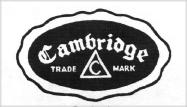 |
Style 1 is apparently the oldest and has the word TRADEMARK added to the original version. Its use probably began in 1927 and when used as a label, measures 9 mm x 16 mm. |
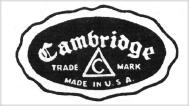 |
Style 2 has the words MADE IN U.S.A. added beneath the Triangle C. Seen in trade advertising dating to early 1930, it is not known if this mark, in label form, was actually used on glassware. It is hard to believe it wasn't. |
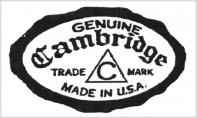 |
Style 3 adds the word "GENUINE" at the top of the oval and in label format, measures 11 mm by 17 mm. Based on trade advertisements, this style was used from May 1930 through 1932. It is shown here in reverse. Lettering remained yellow on a black background. |
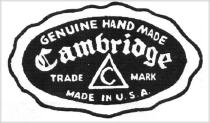 |
Style 4, which was the last of the Cambridge labels to use the Triangle C, added HAND MADE after the word GENUINE. As a label, it measures 11 mm x 19 mm and was in use from 1933 through 1937. |
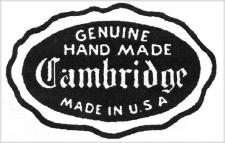 |
In the January 1938 issue of China, Glass And Lamps this notice appeared: "NEW CAMBRIDGE MARK - The Cambridge Glass Co., Cambridge, Ohio manufacturer of hand made glassware, announce a change in the size and make-up of the identification tab they place on their products. The size has been increased by half, and the arrangement and lettering has been enlarged. The new mark is oval in shape with the word 'Cambridge' in Old English type in the center. Above are the words 'Genuine Hand Made' while below is the phrase 'Made in U.S.A.' The tab is in gold on black." |
Thus Cambridge announced to the trade its new trademark, a trademark that was used in advertising, on packaging, and in the form of a label, on glass. The original label size was 16 mm by 28 mm. Research done by David Rankin indicates that in 1942 a smaller version was created, measuring 12 mm by 20 mm. The reason for the change is unknown. Like their predecessors, the 1938 and 1942 labels were printed on paper, gold on black.
This was the last general line trademark to be used by the original Cambridge Glass Company and was employed until the company, in June 1954, ceased operations.